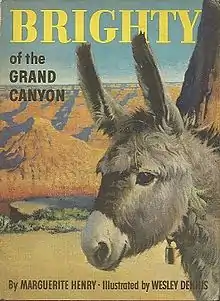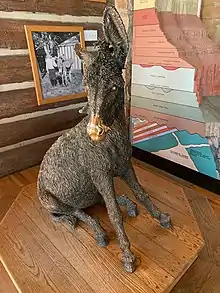Brighty of the Grand Canyon
Brighty of the Grand Canyon is a 1953 children's novel by Marguerite Henry and a 1966 film of the same name based on the novel. They present a fictionalized account of a real-life burro named "Brighty", who lived in the Grand Canyon of the Colorado River from about 1892 to 1922.[2]
 First edition | |
| Author | Marguerite Henry |
|---|---|
| Illustrator | Wesley Dennis |
| Country | United States |
| Language | English |
| Publisher | Rand McNally (1953) Aladdin (1991) |
Publication date | November 1953[1] |
| Pages | 222 |
| ISBN | 978-0-689-71485-6 (second printing) |
| OCLC | 305533 |
| Brighty of the Grand Canyon | |
|---|---|
 Theatrical release poster | |
| Directed by | Norman Foster |
| Produced by | Stephen F. Booth for Stephen F. Booth Productions |
| Screenplay by | Norman Foster |
| Based on | Brighty of the Grand Canyon by Marguerite Henry |
| Starring | Joseph Cotten Pat Conway Dick Foran Karl Swenson Dandy Curran |
| Music by | Phyllis Lavsky Richard Lavsky |
| Cinematography | Ted Saizis Vincent Saizis |
| Edited by | Joseph Dervin |
| Distributed by | Feature Film Corporation of America |
Release date |
|
Running time | 89 minutes |
| Language | English |
History
Brighty first appears in the annals of history in 1890 in Flagstaff, Arizona, in the possession of two men who were on their way to the Grand Canyon. He is next recorded on the South Rim where he and his owners were seen to enter the Canyon via the Bright Angel Trail. Shortly after that two herdsmen entered the canyon to attempt to find the remains of an earlier drowning victim along the Colorado. Instead, they found a camp at the confluence of the Colorado and Bright Angel Creek that was abandoned with the exception of Brighty. It appeared that the two men had saddled and ridden their horses down to and into the Colorado wherein they presumably drowned. Their identities were never determined and their bodies were never recovered.[3]
Originally named "Bright Angel" after a creek that flowed into the Grand Canyon from his summer dwelling on the North Rim, Brighty spent summers carrying water from a spring below the rim to accommodate tourists coming to the Canyon. He was gentle and popular with children.[4]
Brighty was the first to cross the suspension bridge built over the Colorado River at the base of the canyon, having assisted with building of the structure. The burro accompanied U.S. President Theodore Roosevelt while he hunted mountain lions.[5] (The role of Roosevelt is portrayed in the film by Karl Swenson.)[6]
Book and film
Henry penned her novel after she read an article about Brighty in Sunset Magazine. It won the 1956 William Allen White Children's Book Award.
Thomas McKee, the former manager of Wiley's Camp on the North Rim of the Canyon, read Henry's novel and wrote to express his interest in the book. McKee told Henry that his son, Bob, was Brighty's closest companion. He sent Henry a photograph of young Bob McKee sitting on Brighty's back. The youngster became the composite character Homer Hobbs,[5] played in the film by Dandy Curran.[7]
The other film characters include Old Timer, a prospector played by Dick Foran, and Uncle Jim Owen, a man of the Old West played by Joseph Cotten.[7] Pat Conway appears as Jake Irons, who murders Old Timer for his copper ore. Uncle Jim then proceeds to help bring Irons to justice.[8] Parts of the film were shot at the Colorado River in Utah and the Grand Canyon in Arizona.[9]
Brighty's monument

Brighty is honored with a bronze statue in the lobby of Grand Canyon Lodge,[10] a National Historic Landmark,[11] located near Arizona State Route 67 approximately 43 miles south of the junction with U.S. Route 89 alternate route. The sculpture is by artist Peter Jepsen.[12] The monument of stone walls and timbers has a memorial inscription written by Marguerite Henry: "the artist captured the soul of Brighty, forever wild, forever free."[5]
Park visitors frequently stroke the nose of Brighty for good luck, and the statue's "muzzle is polished by thousands of hands".[13]
See also
References
- "Independent Burro; BRIGHTY OF THE GRAND CANYON. By Marguerite Henry. Illustrated by Wesley Dennis. 222 pp. Chicago: Rand McNally & Co. $2.95". New York Times. 1953-11-15. p. BRA34.
- Henry, Marguerite (1953). Brighty: Of the Grand Canyon. ISBN 0689714858.
- Ghiglieri, M. P. & Myers, T. M., 2001: Over the Edge: Death in Grand Canyon, Puma Press, Flagstaff. Ed. 1, Rev. 11, pp 184-185
- Henry, Marguerite (1953). Brighty of the Grand Canyon by Marguerite Henry. ISBN 9780689714856. Retrieved January 19, 2010.
- "Brighty of the Grand Canyon (film and novel)". horsefame.tripod.com. Retrieved January 19, 2010.
- "In Memory of Karl Swenson (1908-1978)". zunshine.com. Retrieved January 18, 2010.
- "Brighty of the Grand Canyon". Internet Movie Data Base. Retrieved January 19, 2010.
- "Overview for Brighty of the Grand Canyon". tcm.com. Retrieved January 19, 2010.
- D'Arc, James V. (2010). When Hollywood came to town: a history of moviemaking in Utah (1st ed.). Layton, Utah: Gibbs Smith. ISBN 9781423605874.
- "National Register Information System". National Register of Historic Places. National Park Service. March 13, 2009.
- "Grand Canyon Lodge". National Historic Landmark summary listing. National Park Service. Archived from the original on 2009-08-02. Retrieved 2010-02-01.
- Lago, Don (2014). Canyon of dreams : stories from Grand Canyon history. University of Utah Press. pp. 174f. ISBN 9781607813156.
- Van Rheenen, Erin. "The Life and Times of Brighty, the Grand Canyon's Most Legendary Burro; He was a muse, a good luck charm, and the center of a controversy over invasive species.". AtlasObscura.com. Atlas Obscura. Retrieved 3 May 2018.